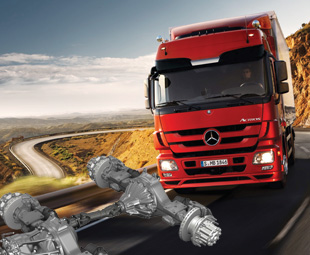Part(s) and parcel

South Africa’s local components, parts and accessories industries are feeling the crunch from the east, as cheaper products are streaming into the country … But JACO DE KLERK discovers that the picture isn’t as grim as we think.
One of the major challenges facing both the commercial and passenger vehicle industries – as Les Mc Master, chairman of the Motor Industry Workshop Association (MIWA), explains – is the escalating price of good quality components and parts … “To ensure that standards are met by our accredited workshops, our members are paying top dollar for parts, despite cheap and inferior options being available,” he says.
However – as Deon Goch, MD of Goch and Cooper Autoservices, explains – this spike in prices has some pitfalls of its own, creating a direct knock-on effect to the consumer. “Consumers cannot afford to do all the repairs needed on their vehicles, resulting in fewer repairs being carried out,” he warns. “This results in more unsafe vehicles on our roads and further complications in the long run for the consumer.”
Goch adds that, along with the price of components, workshop owners also struggle with the availability and quality of parts, which results in downtime of vehicles. “There’s been a huge influx of parts that are of a substandard quality,” he points out.
However, both workshops and consumers are being offered some respite. Mc Master explains: “As a representative body we’ve teamed up with automotive engineering shops to have failures of parts reported to the correct associations and, where a trend is detected, the parts distributer or importer is confronted. We encourage consumers and workshop owners to report overpricing of parts and inferior products to industry bodies such as MIWA so action can be taken.”
But everything out of the east isn’t a disappointment … Greg Cline, head of sales at Blue Strata – an integrated end-to-end import and working capital specialist, says Japan is looking to establish key centres of production outside of the country to ensure the sustainability of its automotive industry. “This is very positive news for our local industry and shows that government’s efforts to develop the local automotive component sector are really paying off.”
He adds: “South Africa already has an excellent track record and skills base in the automotive industry as government has driven specific and focused programmes to attract new investment. This new collaboration should provide great stimulus to further drive the up-skilling and training of people employed within the automotive industry.”
Japan has also reportedly agreed to deploy “master trainers” to promote improved manufacturing and productivity in order to enhance South Africa’s competitiveness in the sector.
“Increased training for employees in these key sectors is critical for the economic growth of South Africa,” Cline points out. “We have a huge labour force keen to learn and grow their skills in order to make themselves and our industries far more competitive.”
 So, things are looking brighter for our local components and parts market, especially if you add this collaboration to the already impressive happenings in South Africa …
So, things are looking brighter for our local components and parts market, especially if you add this collaboration to the already impressive happenings in South Africa …
One example, that’s testament to our country’s industry, is a partnership between General Motors South Africa (GMSA) and component manufacturer Tenneco South Africa (SA) that has been awarded a R6 billion contract to export catalytic converters to North America.
The catalytic converters, which will be manufactured at Tenneco SA’s Clean Air plant in Port Elizabeth, will be supplied to GM’s next-generation V6 engines that will be used for vehicles built and sold in the United States from 2015 to 2022.
The two South African companies have worked together for over 12 years, producing catalytic converters and related components for the North American market. GMSA’s current exports stand at 2,6 million catalytic converters per annum for fitment to 17 percent of vehicles produced by General Motors (GM) globally.
“The decision to award this contract to South Africa is a great show of support by our parent company,” says GM Africa president and MD Mario Spangenberg, “as it comes ahead of a clear legislative framework by the South African government to support the strategic growth of exports.”
Johnny Saldanha, vice president of global purchasing and supply chain for GM International Operations, adds: “A key characteristic of vehicle manufacturing is that we often have to plan as far as five years in advance for the next vehicle programmes. We need to have a predictable and clearly defined legislative framework in order to accurately predict future trends and make realistic business plans.”
And this isn’t the only wonderful parts news to come from the Eastern Cape as two Mercedes-Benz Actros 6×4 truck-tractors (the 2644LS/33 and 2654LS/33), fitted with the latest Merceds-Benz RT440 hypoid rear axles (offering a 3,583 ratio) as standard, have achieved significant fuel savings of more than five percent in test runs conducted in the province.
Christo Kleynhans, product manager at Mercedes-Benz Trucks, says: “The new RT440 hypoid rear axles make for the most fuel efficient Mercedes-Benz 6×4 truck-tractors of all time. In fact, the fuel saving achieved on the 2644LS/33 was 5,67 percent and on the 2654LS/33 was 5,37 percent.”
He adds that each of the vehicles, with standard interlink trailers and gross combination weights of 49 tonnes and 56 tonnes for the Actros 2644 and 2654 respectively, completed 9 920 km under some of the most extreme conditions on Eastern Cape roads.
The 620 km test route started in East London and followed the N2 over the Kei River then back onto the N6 and over Penhoek Pass – some 1 885 m above sea level and a maximum gradient of 10 percent, with the accumulated climbing height for the 620 km route being 9 389 m – before returning to East London.
During the comparative drive the test engineers monitored the vehicles’ fuelling and the swapping of the drivers (who weren’t Mercedes-Benz driver trainers, but normal fleet drivers) and semitrailers. This was done to rule out differences in driving styles and the rolling resistance of the semitrailers that might have distorted the fuel consumption measurements.
“As in normal long-distance operations, the drivers were allowed to travel at a maximum speed of 80 km/h and overrun to 87 km/h on the downhills,” explains Kobus van Zyl, vice president of Mercedes-Benz South Africa commercial vehicles. “All four vehicles were closely monitored on FleetBoard to ensure the drivers followed the testing guidelines at all times. Physical fuel measurements and kilometre readings were also verified against the FleetBoard results.”
So it is clear what impact the correct components and parts can have on your bottom line, which makes the improvement of our, already thriving, local industry even more important.
The influx of products from the east isn’t likely to diminish anytime soon, but South Africa is definitely upping its game.
Published by
Focus on Transport
focusmagsa




